SBI report says bank’s performance will have to be rewritten based on the new data and this can be contentious due to questions over credibility.
New Delhi: The Narendra Modi government’s revised set of back-series GDP data, which slashed the average rate of growth during the UPA regime, pose “reconciliation problems regarding micro and macro data interpretation”, a State Bank of India (SBI) report said Thursday.
A careful data interpretation will be required to vet the new set of figures, the SBI report said.
“Any rebasing exercise also leads to some rewriting of the performance and this, quite naturally, raises a point of contention for the economists — which version is more credible and trustworthy for arriving at the forward projections,” the report added.
The first set of draft data was released in July, and it had pegged UPA-era growth rate at 7.75 per cent. The new revised data now puts that at 6.82 per cent. The NDA growth rate has been pegged at 7.35 per cent.
Niti Aayog chief Rajiv Kumar and Finance Minister Arun Jaitley defended the Central Statistics Office and its new set of data, but the SBI report has raised questions over the GDP growth figures in 2006-07 and 2015-16.
For both financial years, the economic growth figure is about the same at 8 per cent while most other economic indicators are diverse.
Also read: New GDP data has more credibility, says Arun Jaitley
Link with bank credit
The investment rate in 2006-07 was 36 per cent, bank credit 28.5 per cent and sales of commercial vehicle was up by 32 per cent. In 2015-16, the investment rate was 32.3 per cent, bank credit stood at 10.9 per cent while sales of commercial vehicles grew by 12 per cent.
However, the new government data calculates the GDP in FY07 at 8.1 per cent and at 8.2 per cent in FY16.
The report has raised questions over the criticality and co-relation of bank credit with economic growth.
“Does it mean link between the bank credit and GDP has weakened over the years as banks have started accommodating companies through other sources like commercial paper (CP) and bonds?” the report questioned.
Also read: Timing of new numbers bothersome, says economist behind controversial back-series GDP data
Need for credible data
Noted economist Sudipto Mundle, who led the committee which released the first set of back-series GDP data, said that the country’s statistical system and the Ministry of Statistics and Programme Implementation (MoSPI) must be ring-fenced to maintain credibility.
“The whole data generation, MoSPI should be ring-fenced. Statistics is very important though it is considered dry till it hits the headlines, as policy-making in the public sector as well as the private sector is based on data,” Mundle told ThePrint.
The Niti Aayog vice-chairman had said in August that the there was no problem with the data that was published in the draft report in July. He then went on to say that growth during the UPA regime had been propped by indiscriminate bank lending and the stimulus package.
However, Kumar said Wednesday that the previous set of data had some lacunae while the new figures are based on a wider web of information, making them more credible and accurate.
Also read: India’s GDP growth depends on which party was in power & under which party it was measured
